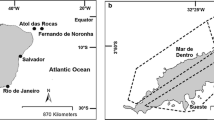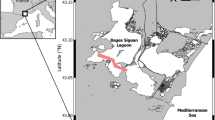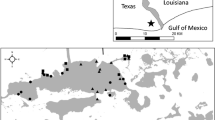Abstract
Seasonal changes in catch rate, growth and mortality of Nassarius reticulatus from an intertidal lagoon and a wave-exposed beach at Rhosneigr (Anglesey, North Wales, UK) are described. The number of N. reticulatus caught in baited traps from the lagoon was significantly higher (>125 individuals trap−1) during the summer (>18°C), than at <12°C (<65 individuals trap−1), and the numbers caught in the lagoon were an order of magnitude greater than on the beach, >13 individuals trap−1 in July (>16°C), and <5 individuals trap−1 between December and April (<9.5°C). Predictions of shell growth attained by N. reticulatus annually in the lagoon using graphical modal progression analysis (MPA) of length frequency data, were similar to the growth of marked and recaptured lagoon N. reticulatus. Predictions of shell growth using computerised length frequency distribution analysis (LFDA), however, did not reflect the growth as accurately as MPA. Modal progression analysis demonstrated that N. reticulatus from the lagoon achieved a higher asymptotic maximum shell length (L∞) and a lower growth constant (K) than animals from the beach. Shell growth was seasonal with growth of the lagoon individuals slowing down towards the end of September and resuming in early April, about a month later than the beach individuals. Mortality of N. reticulatus was greater during the summer, and survival was lower in the lagoon than on the beach. Recruitment patterns were similar in the lagoon and on the beach, and MPA and LFDA predicted that larval N. reticulatus settled between late summer and early autumn, with juveniles (7–8.9 mm) appearing in the population the following year, between February and April. Growth of male and female N. reticulatus in the laboratory was similar and was temperature and size dependent. The different growth patterns between N. reticulatus from the two habitats, predicted using MPA, were maintained when individuals were reared under laboratory conditions for ∼6 months; N. reticulatus <21 mm from the beach grew faster than individuals from the lagoon, although N. reticulatus >21 mm from the lagoon grew faster and attained a larger length (26 mm) than individuals from the beach (24 mm). Low food availability did not affect N. reticulatus survival in the laboratory but significantly suppressed shell growth.








Similar content being viewed by others
References
Appeldoorn RS (1987) Modification of a seasonally oscillating growth function for use with mark–recapture data. ICES J Mar Sci 43:194–198
Barroso CM, Moreira MH (1998) Reproductive cycle of Nassarius reticulatus in the Ria de Aveiro, Portugal: implications for imposex studies. J Mar Biol Assoc UK 78:1233–1246
Barroso CM, Moreira MH, Richardson CA (2005) Age and growth of Nassarius reticulatus in the Ria de Aveiro, north-west Portugal. J Mar Biol Assoc UK 85:151–156
Beverton RJH, Holt SJ (1956) A review of methods for estimating mortality rates in exploited fish populations, with special reference to sources of bias. Rapp p v Reun CIEM 140:67–83
Bhattacharya CG (1967) A simple method of resolution of a distribution into Gaussian components. Biometrics 23:115–135
Britton JC, Morton B (1994) Marine carrion and scavengers. Oceanogr Mar Biol Annu Rev 32:369–434
Cerrato RM (1980) Demographic analysis of bivalve populations. In: Rhoads DC, Lutz RA (eds) Skeletal growth of aquatic organisms: biological records of environmental change. Plenum Press, New York, pp 417–465
Chatzinikolaou E (2006) The ecology and growth of the netted dogwhelk Nassarius reticulatus. Ph.D. thesis. University of Wales, Bangor
Chatzinikolaou E, Richardson CA (2007) Evaluating growth and age of netted whelk Nassarius reticulatus (Gastropoda: Nassariidae) using statolith growth rings. Mar Ecol Prog Ser 342:163–176
Curtis LA (1995) Growth, trematode parasitism, and longevity of a long-lived marine gastropod (Ilyanassa obsoleta). J Mar Biol Assoc UK 75:913–925
Ekaratne SUK, Crisp DJ (1984) Seasonal growth studies of intertidal gastropods from shell micro-growth band measurements, including a comparison with alternative methods. J Mar Biol Assoc UK 64:183–210
Elliott JM (ed) (1977) Some methods for the statistical analysis of samples of benthic invertebrates. Freshwater Biological Association. Scientific Publication No. 25
Folk RL (ed) (1968) Petrology of sedimentary rocks. Hemphill’s, University of Texas
Grant A, Morgan PJ, Olive PJW (1987) Use made in marine ecology of methods for estimating demographic parameters from size–frequency data. Mar Biol 95:201–208
Hoenig JM, Hanumara RC (eds) (1982) A statistical study of a seasonal growth model for fishes. University of Rhode Island, Department of Computer Science. Technical Report, Narragansett
Juanes F (1992) Why do decapod crustaceans prefer small-sized prey? Mar Ecol Prog Ser 87:239–249
Lambeck RHD (1984) Dynamics, migration and growth of Nassarius reticulatus (Mollusca, Prosobranchia) colonizing saline lake Grevelingen (SW Netherlands). Netherlands J Sea Res 18:395–417
McKillup SC, Buttler AJ (1983) The measurement of hunger as a relative estimate of food available to populations of Nassarius pauperatus. Oecologia 56:16–22
McKillup SC, McKillup RV (1997) Effect of food supplementation on the growth of an intertidal scavenger. Mar Ecol Prog Ser 148:109–114
McKillup SC, Butler AJ, McKillup RV (1993) The importance of sandflat morphology to recruitment of intertidal snail Nassarius pauperatus during ten consecutive years at three sites in South Australia. Mar Biol 115:577–580
Morales-Nin B (ed) (1992) Determination of growth in bony fishes from otolith microstructure. Food and Agriculture Organisation of the United Nations
Morton B, Chan K (2004) The population dynamics of Nassarius festivus (Gastropoda: Nassariidae) on three environmentally different beaches in Hong Kong. J Molluscan Stud 70:329–339
Munro JL (1982) Estimation of the parameters of the von Bertalanffy growth equation from recapture data at variable time intervals. J Cons Int Explor Mer 40:199–200
Ota N, Tokeshi M (2000) A comparative study of feeding and growth in two coexisting species of carnivorous gastropods. Mar Biol 136:101–114
Parsons KE (1997) Contrasting patterns of heritable geographic variation in shell morphology and growth potential in the marine gastropod Bembicium vittatum: evidence from field experiments. Evolution 51:784–796
Pauly D, Soriano-Bartz M, Moreau J, Jarre A (1992) A new model accounting for seasonal cessation of growth in fishes. Aust J Mar Freshw Res 43:1151–1156
Rabi M, Maravi C (1991) Growth curves and specific growth rate of Concholepas concholepas (Bruguiere, 1789) (Gastropoda: Muricidae) in culture experiments. Sci Mar 61:49–53
Scheltema RS (1964) Feeding habits and growth in the mud snail Nassarius obsoletus. Chesap Sci 5:161–166
Spight TM (1982) Population sizes of two marine snails with a changing food supply. J Exp Mar Biol Ecol 57:195–217
Stroben E, Oehlmann J, Fioroni P (1992) The morphological expression of imposex in Hinia reticulata (Gastropoda: Buccinidae): a potential indicator of tributyltin pollution. Mar Biol 113:625–636
Tallmark B (1980) Population dynamics of Nassarius reticulatus (Gastropods, Prosobranchia) in Gullmar fjord, Sweden. Mar Ecol Prog Ser 3:51–62
Tokeshi M, Ota N, Kawai T (2000) A comparative study of morphometry in shell-bearing molluscs. J Zool Lond 251:31–38
Trussell GC, Smith DL (2000) Induced defenses in response to an invading crab predator: an explanation of historical and geographic phenotypic change. PNAS 97:2123–2127
Wellington GM, Kuris AM (1983) Growth and shell variation in the tropical eastern Pacific intertidal gastropod genus Purpura: ecological and evolutionary implications. Biol Bull 164:518–535
Acknowledgments
The authors are grateful to G. Jones and B. Roberts for their assistance in collecting the Nassarius reticulatus. The experiments complied with the current UK laws.
Author information
Authors and Affiliations
Corresponding author
Additional information
Communicated by A. Atkinson.
Rights and permissions
About this article
Cite this article
Chatzinikolaou, E., Richardson, C.A. Population dynamics and growth of Nassarius reticulatus (Gastropoda: Nassariidae) in Rhosneigr (Anglesey, UK). Mar Biol 153, 605–619 (2008). https://doi.org/10.1007/s00227-007-0835-5
Received:
Accepted:
Published:
Issue Date:
DOI: https://doi.org/10.1007/s00227-007-0835-5




